I’ve often wondered how many children wanted to grow up to become a fire-fighter. I also wonder how many of them finally realized this ambition. If you are one of those that dreamed it but never made it, then perhaps this 1956 Dodge Power Wagon can at least allow you to let loose your imagination. This retired fire-fighting appliance is one of the most innovative fire-fighting appliances ever built in the USA and would make a fantastic restoration project. It is also worth taking a serious look at this because buying and restoring it could be a canny financial move. It is located in Saint Johnsville, New York, and is listed for sale here on eBay. Bidding on this classic has reached $3,050, but the reserve hasn’t been met.
I really love these old fire-fighting appliance, and this one is pretty cool. I’m not going to pretend for one moment that it would be an easy restoration, because there is an awful lot of metal that would require preparation and painting. The plus side of this is that the old Dodge looks to be pretty clean and free of major rust issues. The frame also appears to be solid, and while those side steps are probably original, the enormous front bumper would not have been fitted to the vehicle in its fire-fighting role.
Necessity is the mother of invention, and this is one of the most inventive fire-fighting solutions that America has ever seen. The brainchild of a mechanical lateral thinker by the name of Walter “Army” Armstrong, what you are looking at is a fire-fighting appliance that was designed to fight anything from scrub fires to chemical fires and to undertake all of this operated by one person. The “Little Mo,” as it became known, was built initially in small numbers by the Young Fire Equipment Company of Buffalo, New York, from 1954 until 1956. American LaFrance then took up construction from 1958 until 1960. This Little Mo retains most, but not all, of its original equipment. That turret-mounted nozzle was operated by a cable, meaning that the operator never had to leave the truck’s cab to tackle a fire. The pump on the front of the vehicle was dual purpose. At a fire, it would feed water from an onboard tank to the nozzle, but once the tank was empty, it could then be used to draft water from the nearest pond, dam, or river, to refill the tank. The onboard water tank, which is missing, would normally have held upwards of 200 gallons. When running at full noise, the pump could deliver 90 gallons per minute, meaning that the tank could potentially be emptied in just over two minutes. There also would have been a 20-gallon foam tank, along with a 5-gallon tank of wetting agent. Combine those and you were ready to tackle most chemical fires. What made it all the more ingenious is that I can still see some pipes visible behind that huge (and non-original) front bumper. These would have fed water or foam to a pair of nozzles mounted at bumper level, which allowed the operator to fight fires both from above and below….and all from the comfort of the truck’s cab.
The interior of the Power Wagon looks to also be in impressive condition for a fire-fighting appliance of this age. There are no real problems to report, and everything looks to be quite serviceable. From a fire-fighting perspective, the most important news is that all of the fire controls for the pump, tanks, and nozzles are still in-situ in the dash. This is a massive bonus, because finding genuine items is now incredibly difficult, especially when these controls are specifically the ones fitted by Young Fire Equipment, not LaFrance. For the person considering a restoration, that is going to potentially save them a lot of leg-work.
Providing the motive power for the Dodge is a 230ci flathead six-cylinder engine, backed by a 4-speed manual transmission. Of course, this is a 4×4, meaning that it has fantastic “go anywhere” potential, and explains why it was the perfect choice for this role. It isn’t clear how long the Power Wagon has been out of service, but the great news is that it runs and drives. Hopefully, it won’t take much to get this beast ready to tackle blazes again.
I’ve written about some really interesting fire-fighting appliances in the past, but the Little Mo is one of the coolest. The initial production run from Young’s yielded only limited numbers of vehicles, but actual totals aren’t clear. American LaFrance built them in far greater numbers, as you would expect from a company of their size. When I said that restoring this might be a canny move, I was deadly serious about that. An exhaustive search has revealed that there is only one known restored Little Mo in existence today, and it is a LaFrance version. This one is definitely a Young’s vehicle, and when it is restored, it could potentially be one of the rarest fire-fighting appliances in the US. To put that into perspective, the other Little Mo went to auction in 2017. It sold for $59,400. This Little Mo is from a far lower production run, so once restored, it could conceivably sell for quite a bit more. This is a big project, but it is one that could be worth a serious look.
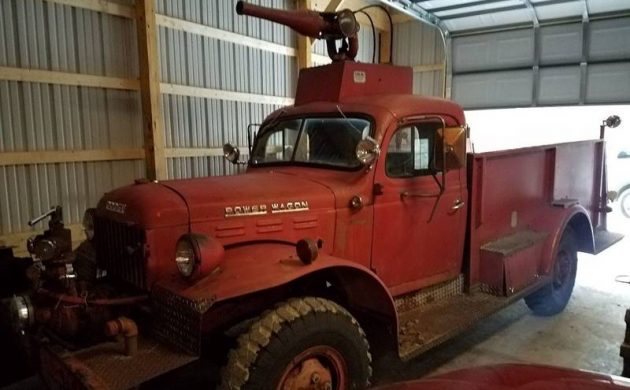
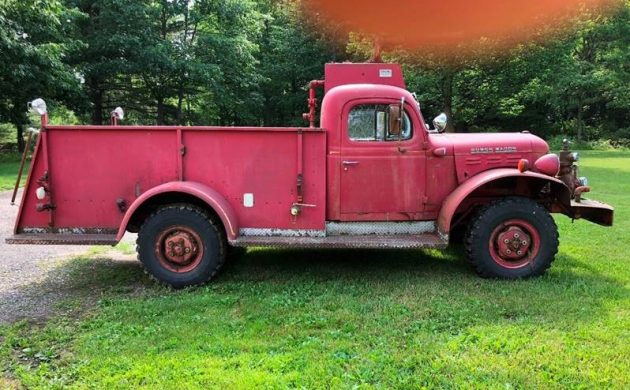
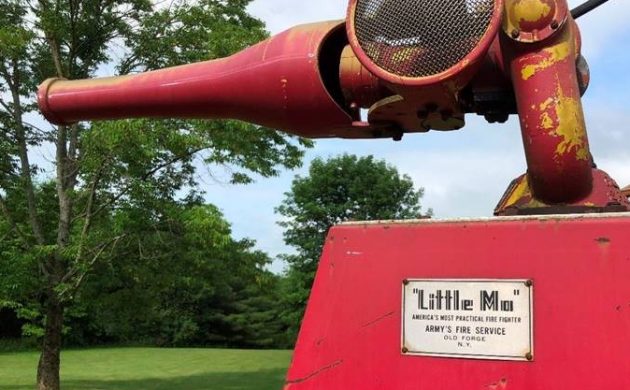

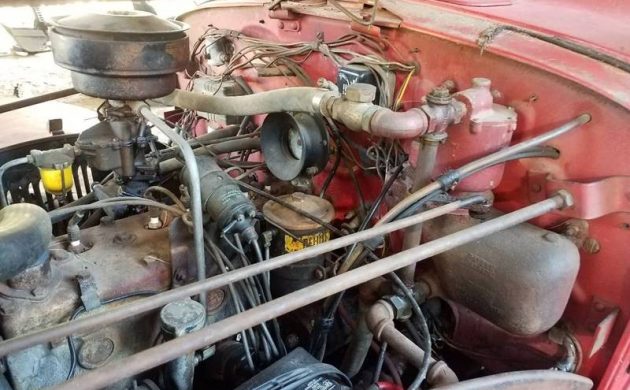
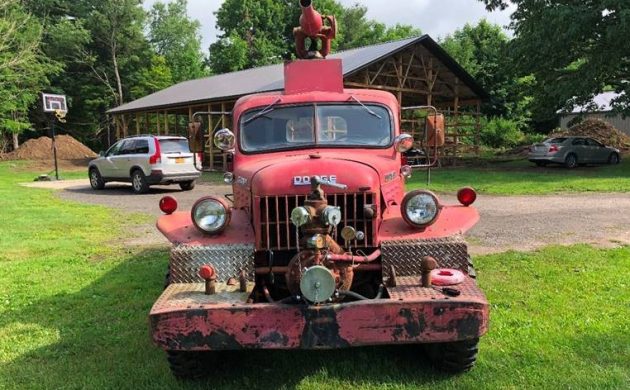




Not sure why you’re hung up on the originality of the front bumper; I guarantee that bumper was put on when all of the rest of the firefighting equipment was installed. It probably came from Dodge as a cab and chassis. The front bumper was necessary to protect that front mounted pump.
I’ve seen those front mountings on many fire apparatus from that time period.
That is indeed a correct front bumper for that firefighting configuration. As Brent said, it’s to protect that pump. Something else to research and learn about while you’re figuring out what Door Panels are.
Lol @ capnemo
Dodge Power Wagons were extremely popular as a platform for small fire apparatus.The front-mount pump location is frequently used by departments in areas where hydrants are few or non-existent since they can be easily pulled up to a drafting site and set up much faster than a conventional midship design. That extended front bumper is typical of front-mount design.
Young Fire Apparatus manufactured until about 1990-91. They were a small and extremely innovative builder in the Buffalo area most we’ll known for their “Young Crusader” model chassis. Anyone here who has been in the fire service for a while, especially on the east coast will probably recall the Crusader, BTW, LaFrance is also now gone, so no help there, although there wouldn’t be much in the way of propriety parts needed. Young didn’t make pumps, could be a Hale or Waterous and they’re still around. An interesting rig that would make a beautiful restoration.
RE: 1st sentence,,,um, no. From an early age I knew, I would run out of a burning building, while fire fighters run in. While this doesn’t look like much now, I bet at one time, this truck was the cat’s axx, and probably cost a pretty penny when new. IDK what to do with it. Horribly inept for fighting todays mega fires, it will probably continue to rot. Or strip it out for just the Power Wagon part. I can’t make out the mileage, needle hiding 1st digit, but generally these had low use, and probably has 12K miles on it.
I am about halfway through a complete frame off resto on an original 50 Power Wagon, I found one with 18k original miles. My truck will be restored back to almost it’s original condition all but it will be a 12 volt system instead of 6 volt.
Because of the current EXTREME popularity of these trucks I feel strongly this will be restored to an incredible deep time appropriate re-created and original in virtually every way. This is a POWER WAGON started production in 46 and the stopped NEVER to produce another on around 66. This may piss some folks off but stickers and other nonsense do NOT make POWER WAGON! This truck is worth a lot as it sits, I can’t imagine what it’s worth restored?
Power Wagons continued to be available in Canada through the 1975 model year.
Kevin were these REAL Power Wagons like this one, or a stickered up modern pickup?
So where I live, high in the California fire prone mountains, this would certainly be useful. I’ve been trying to get our Fire Safe Council to pony up for one of these small trucks I see on BF ever since our Volunteer Fire Dept was absorbed by CalFire. No luck yet
That said, I too am curious why the writer, Adam Clarke, of Oz, thinks the bumper isnt original. Sure looks purpose built to me. Also I wonder what the tank would look like….anyone know?
Man. I love it.
Be a great Truck to haul around Federal Clown Politicians in .
We actually own this unit and the water tank is not pictured but we have it. It is completely intact but needs a restoration. I wish we had the time to restore it but in all honesty we do not. Anyone interested in information on this unit can reach out to us @[email protected]. It was in service until approximately 1985.
I’d like to know what a chemical fire is, Adam. I only know of five classes of fires – A, B, C, D, and K. Please refrain from taking so much literary license.
Oh yeah, about that bumper. Have you ever seen a fire truck in person?